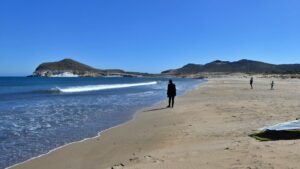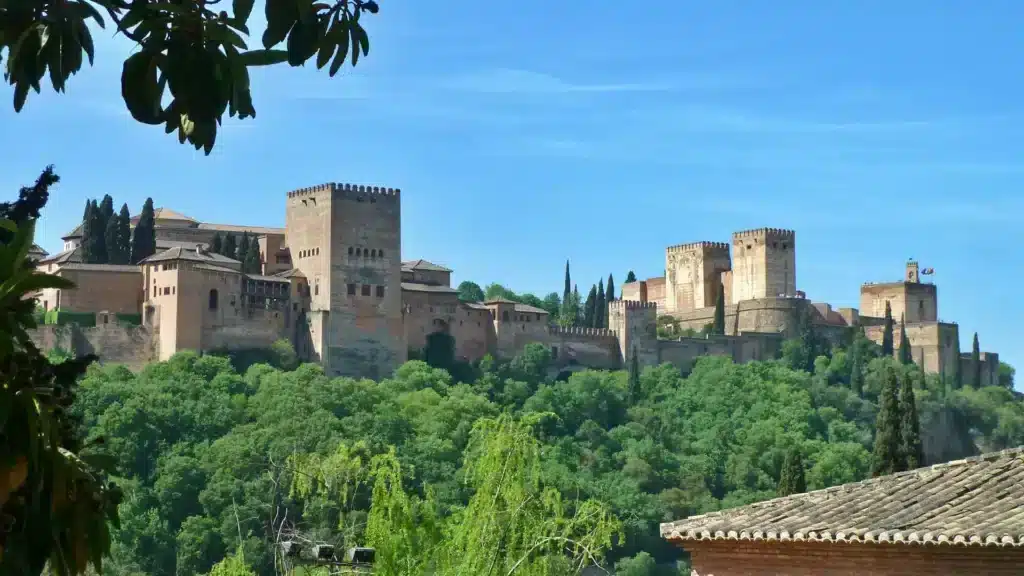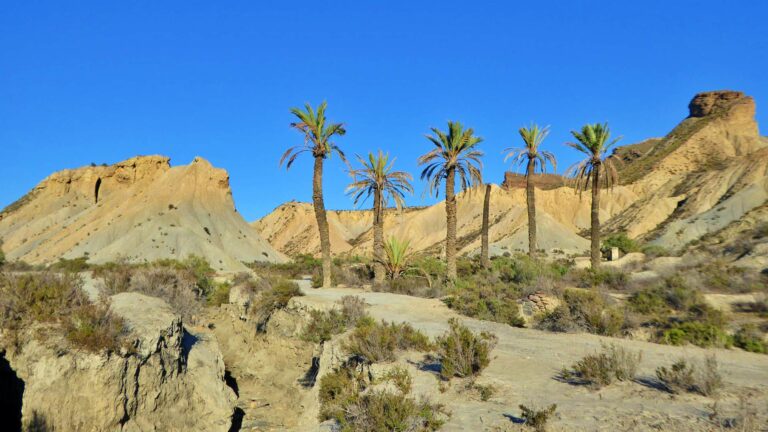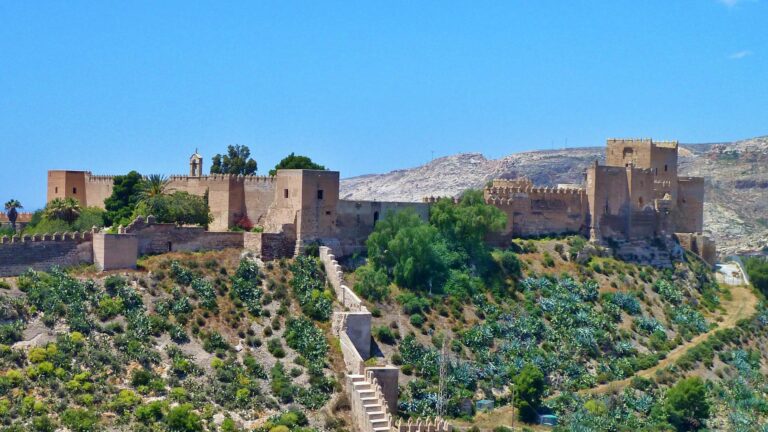Mojácar Pueblo
discover the magical white village of Andalusia
Mojácar Pueblo
The most beautiful white village in Almería
Since 2003, Mojácar Pueblo has officially been one of the most beautiful white villages in Spain. Every year a new jury evaluates this and we are always there 🙂
The village is located at the end of the Sierra Cabrera in the east of the province of Almería, on a hill about 170 metres above sea level. It is definitely a wonderful destination to spend your holidays.
This particular village is divided into two areas: Mojácar Pueblo (the village) and Mojácar Playa (the beach). Its clean beaches stretch for about 17 km and many have the blue flag seal of approval, guaranteeing carefree bathing fun.
The Village
Mojácar Pueblo already looks impressive from a distance.
The houses are located on top of a small mountain, the last foothill of the Sierra Cabrera. Their white façades stand in high contrast to the brown shades of the surroundings and the bright blue of the sky and the sea. The roofs are flat or terraced and leave you with the idea that the houses are cubic. From the outside, you can only imagine the labyrinth of streets and alleys.
Inside, then, you discover the charming beauty of the narrow streets. The walls of the houses are decorated with colourful flowers that blend in beautifully with the white of the houses and the intense blue of the sky. Every corner catches the visitor’s eye and takes you back to the Moorish past. Spectacular views suddenly pop up in many places – of the sea to the east, the vast plain with the Rio Aguas to the north-west, or the Sierra Cabrera to the south.
Now, I am anything but an expert on Mudéjar architecture, but I once read that the Moors designed the stairways in villages so that they offered a particularly magnificent view. No matter if this statement is true or not – in Mojácar it is definitely the case. Sometimes you just have to face the stairs in both directions 😉 .
No doubt, it is not surprising that Mojácar is considered to be one of the most beautiful white villages in Spain.
The history of Mojácar Pueblo:
Discover the origin of our white village
The name Mojácar derives from „Monxacar“ and stands for „Holy Mountain“. The city has a thousand-year history that began in prehistoric times and has since absorbed many other peoples and cultures such as the Phoenicians, Celts, Greeks and Romans before the era of the Moorish Kingdom.
Later, the Spanish reconquered large parts and Mojácar plays a remarkable role during this Spanish Reconquista in Andalusia. Although almost all the villages in the region surrendered to the Catholic royal couple (Ferdinand and Isabella) in 1488, Alavez, the Moorish ruler of Mojácar, refused to hand over the town and its inhabitants to the Spanish.
When asked why he did not show up at a surrender meeting at the Fuente Mora, the village’s Moorish well, he reportedly replied that he was as Spanish as the Catholic royal couple, but that he would never want to go to war against the Christians. He then added the wish that the people of Mojácar be treated as brothers and not enemies, and that they wished to continue cultivating the land and controlling their city, in a peaceful alliance with Spain, of course. King Ferdinand and Queen Isabel accepted Alavez’s diplomatic proposal, thus preserving the prosperity of Mojácar and its inhabitants.Even today, this history is duly celebrated during the Fiesta de los Moros y Cristianos.
However, Mojácar’s greatest heyday was yet to come. Silver was discovered in Mojácar in the early 19th century and heralded an economic boom. Unfortunately, dark times soon came to the town. The mines were closed at the beginning of the 20th century and the village suffered severely from war, drought and disease. The impact on Mojácar was further exacerbated by the Spanish Civil War and the economic problems that accompanied it. The population decreased drastically as many inhabitants emigrated to Argentina and the USA.It was not until the 1960s that Mojácar recovered a little after the mayor devised a plan to offer land or houses for free to those who would work to restore the run-down town. Until then, the town was not even supplied with running water. The mayor’s plan sounded like music to artists, journalists and intellectuals who had fallen in love with Mojácar’s beautiful location and rich history.
Thanks to their efforts, Mojácar picked itself up again and in addition to the renovation of the village houses, new residential areas were created on the coast and Mojácar developed into a hippie hotspot.
Even today, Mojácar Pueblo manages to preserve parts of its Moorish past, and these influences blend beautifully with modern and contemporary architecture. This mix of old and new gives the place its distinctive character and gives visitors the opportunity to enjoy a unique atmosphere where past and present combine.
Discover Walt Disney’s birthplace
Did you know that Mojácar Pueblo is believed to be the true birthplace of none other than Walt Disney?
In 1901, at the time of the great migratory flows, a baby born of an extramarital affair between the laundress Isabel Zamora and the powerful Gines Carrillo left southern Spain with his mother for Chicago. This baby was named Jose Guirado Zamora and was eventually adopted in America by Elias Disney and his wife.
Unfortunately, there is no proof, although many people in Mojácar are still working on it. There are many indications that the story could be true. Walt Disney took the truth with him to his grave and so we will probably never know it.
To find out more about the story, just type „Walt Disney Mojácar“ into Google and you’ll get articles in every language. We were totally gobsmacked that the press from pretty much every country had already reported on it …
Places of interest in Mojácar Pueblo
If you want to know all about the history of Mojácar Pueblo (and walk it – note: Mojácar is on a mountain 🙂 ), there are a number of places you should definitely visit.
La Fuente Mora
… the Moorish fountain where the last Moorish king peacefully offered his surrender to the Catholic royal couple. Also take the time to read the plaque located above the fountain’s 12 jets of water.
Directly above the Fuente, by the way, is the modern Centro de Arte Contemporáneo del Municipio, which opened in 2010.
Puerta de la Ciudad
The original gate to the city, built in 1574, in the Plaza de los Flores. From the back it still bears the original Arabic inscription of the village of Mojácar.
Casa de Torreon
The renovated building near the town gate used to house the customs house and now houses a small accommodation and an inn.
Barrio del Arrabal
The 17th century Jewish quarter of Mojácar is characterised by narrow streets and vivid colours. It begins just beyond the city gate.
The Town Hall
The town hall of Mojácar stands on a picturesque square with a beautiful and huge Ficus benjamini, which an emigrant brought from America 100 years ago.
Plaza del Parterre
This is the old Arab cemetery, of which, however, nothing can be seen today. It is a beautiful plaza decorated with many flowers and plays a major role in local festivals.
Iglesia de Santa Maria
Next to the Plaza del Parterre is the Church of Santa Maria. In Moorish times it was a mosque, after the Reconquista a fortress, which unfortunately later almost completely fell victim to a fire. After its reconstruction as a Catholic church, its altarpiece was painted by a German artist.
In the square in front of the church is the statue of the „Mojaquera“, a marble effigy of the women of Mojácar, depicted in typical garments that highlight their traditional role as water carriers.
El Mirador del Castillo
From up here you can enjoy a wonderful view directly onto the sea. The old well of Muslim origin has been restored and now houses a museum.
Plaza Nueva
The lively main square of Mojácar is invariably full of tourists having a drink in one of the cosy bars or enjoying the breathtaking view from the Mirador. This fantastic vantage point offers a view of the so-called Valley of the Pyramids and over the Sierra Cabrera, the village of Bédar and the Sierra Alhamilla beyond.
Ermita
The Ermita de Nuestra Señora de los Dolores, was built in the 16th century on the foundations of a Moorish mosque. The hermitage is now privately owned and houses a souvenir shop.
Museo Casa de la Canana
This museum offers a trip back in time to see how the people of Mojacar lived in the early 20th century.
The Casa de la Canana museum opened in September 2018 and the approximately 200 square metres of the museum reflect the traditional atmosphere of a Mojaquera house. There are also traditional tools and Mojaquera costumes used at the beginning of the last century.
Mojácar Playa – 17km sun, sand and sea
The beaches of Mojácar are almost exclusively sandy, sometimes very fine and sometimes a little coarser. Here and there there are also a few pretty rock formations where you can watch the cormorants resting before they go hunting again.
There are many chiringuitos – that’s what beach bars are called in Spain. If you want to know more about them and everything that has to do with food and drink in our region, you can download our EBook here.
Playa de las Ventanicas / Playa del Bancal
The most beautiful stretch of beach in Mojácar Playa is undoubtedly Playa de las Ventanicas to Playa del Venta del Bancal.
The sand is super fine, the chiringuitos offer comfortable beach loungers, sun umbrellas and, for the lazy among us, free delivery of drinks to the lounger. At lunchtime, you can have a tasty snack there and then go back to your sun lounger, or siesta.
The sea is beautifully clear here, so there’s really nothing to stop a carefree day at the beach.If you are looking for beaches away from the hustle and bustle, you will also find three beautiful natural beaches outside Mojácar, except that here again you have to look after yourself.
The first two are right next to each other and can be reached via a „mogul slope“ from Torre de Macenas.
The Torre de Macenas on the beach of the same name is an old 18th century watchtower that is still well preserved.
Playas de Bordenares y Playa de Sombrerico
On the way south, you also pass the Torre de Pirulíco, another watchtower, to end up at the deserted beach Playa de Bordenares. Here you will always find peace and quiet out of season and even in high season this beach is rarely crowded.
Only a few hundred metres further, you reach Playa de Sombrerico. Due to the many rocks, this beach is better suited for snorkelling. There is also a nice chiringuito here from June to September. Manacá offers super tasty food, a good ice-cold beer and always clean toilets.A little further south, on the road from Mojácar Playa to Carboneras, you will eventually reach a small hamlet called Sopalmo. Here there is a small, very popular tapas bar and the way down to the Rambla of Sopalmo. From here, after 10 min. mogul track to the
Playa Granatilla
Actually, there are three beaches. The finest sandy beach, crystal clear water, always interrupted by rock formations. If you climb over the rocks all the way to the end, you come to a last little bay where hardly anyone ever gets lost 🙂











